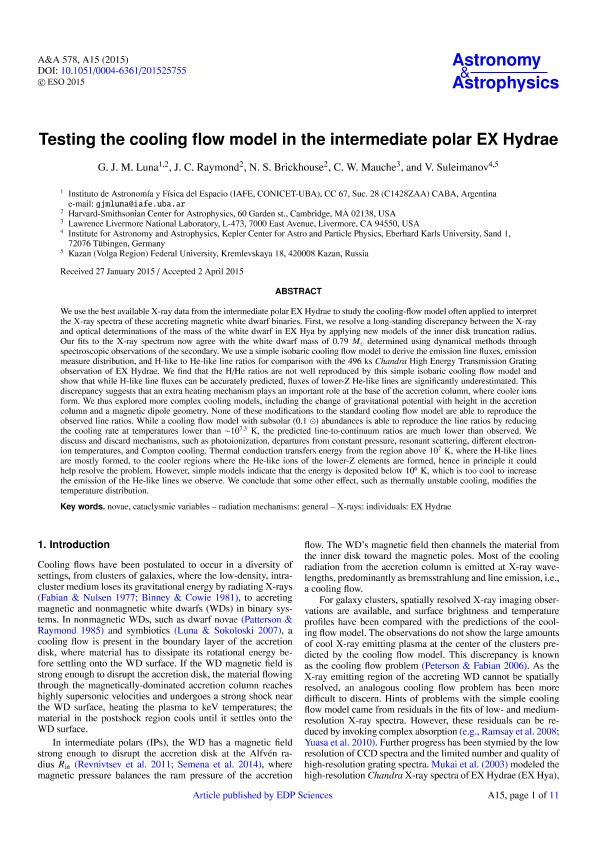Mostrar el registro sencillo del ítem
dc.contributor.author
Luna, Gerardo Juan Manuel

dc.contributor.author
Raymond, J. C.
dc.contributor.author
Brickhouse, N. S.
dc.contributor.author
Mauche, C. W.
dc.contributor.author
Suleimanov, V.
dc.date.available
2017-06-06T18:49:04Z
dc.date.issued
2015-05
dc.identifier.citation
Luna, Gerardo Juan Manuel; Raymond, J. C.; Brickhouse, N. S.; Mauche, C. W.; Suleimanov, V.; Testing the cooling flow model in the intermediate polar EX Hydrae; Edp Sciences; Astronomy And Astrophysics; 578; 15; 5-2015; 1-11
dc.identifier.issn
0004-6361
dc.identifier.uri
http://hdl.handle.net/11336/17596
dc.description.abstract
We use the best available X-ray data from the intermediate polar EX Hydrae to study the cooling-flow model often applied to interpret the X-ray spectra of these accreting magnetic white dwarf binaries. First, we resolve a long-standing discrepancy between the X-ray and optical determinations of the mass of the white dwarf in EX Hya by applying new models of the inner disk truncation radius. Our fits to the X-ray spectrum now agree with the white dwarf mass of 0.79 M determined using dynamical methods through spectroscopic observations of the secondary. We use a simple isobaric cooling flow model to derive the emission line fluxes, emission measure distribution, and H-like to He-like line ratios for comparison with the 496 ks Chandra High Energy Transmission Grating observation of EX Hydrae. We find that the H/He ratios are not well reproduced by this simple isobaric cooling flow model and show that while H-like line fluxes can be accurately predicted, fluxes of lower-Z He-like lines are significantly underestimated. This discrepancy suggests that an extra heating mechanism plays an important role at the base of the accretion column, where cooler ions form. We thus explored more complex cooling models, including the change of gravitational potential with height in the accretion column and a magnetic dipole geometry. None of these modifications to the standard cooling flow model are able to reproduce the observed line ratios. While a cooling flow model with subsolar (0.1 ) abundances is able to reproduce the line ratios by reducing the cooling rate at temperatures lower than ∼10 7.3 K, the predicted line-to-continuum ratios are much lower than observed. We discuss and discard mechanisms, such as photoionization, departures from constant pressure, resonant scattering, different electron-ion temperatures, and Compton cooling. Thermal conduction transfers energy from the region above 10^7 K, where the H-like lines are mostly formed, to the cooler regions where the He-like ions of the lower-Z elements are formed, hence in principle it could help resolve the problem. However, simple models indicate that the energy is deposited below 10 6 K, which is too cool to increase the emission of the He-like lines we observe. We conclude that some other effect, such as thermally unstable cooling, modifies the temperature distribution.
dc.format
application/pdf
dc.language.iso
eng
dc.publisher
Edp Sciences

dc.rights
info:eu-repo/semantics/openAccess
dc.rights.uri
https://creativecommons.org/licenses/by-nc-sa/2.5/ar/
dc.subject
Novae, Cataclysmic Variables
dc.subject
Radiation Mechanism
dc.subject
General: X-Rays
dc.subject
Individual: Ex Hydrae
dc.subject.classification
Astronomía

dc.subject.classification
Ciencias Físicas

dc.subject.classification
CIENCIAS NATURALES Y EXACTAS

dc.title
Testing the cooling flow model in the intermediate polar EX Hydrae
dc.type
info:eu-repo/semantics/article
dc.type
info:ar-repo/semantics/artículo
dc.type
info:eu-repo/semantics/publishedVersion
dc.date.updated
2017-06-06T14:48:15Z
dc.journal.volume
578
dc.journal.number
15
dc.journal.pagination
1-11
dc.journal.pais
Francia

dc.journal.ciudad
Paris
dc.description.fil
Fil: Luna, Gerardo Juan Manuel. Consejo Nacional de Investigaciónes Científicas y Técnicas. Oficina de Coordinación Administrativa Ciudad Universitaria. Instituto de Astronomía y Física del Espacio. - Universidad de Buenos Aires. Facultad de Ciencias Exactas y Naturales. Instituto de Astronomía y Física del Espacio; Argentina. Harvard-Smithsonian Center for Astrophysics; Estados Unidos
dc.description.fil
Fil: Raymond, J. C.. Harvard-smithsonian Center For Astrophysics; Estados Unidos
dc.description.fil
Fil: Brickhouse, N. S.. Harvard-smithsonian Center For Astrophysics; Estados Unidos
dc.description.fil
Fil: Mauche, C. W.. Lawrence Livermore National Laboratory; Estados Unidos
dc.description.fil
Fil: Suleimanov, V.. Kazan Federal University; Rusia. Eberhard Karls University; Alemania
dc.journal.title
Astronomy And Astrophysics

dc.relation.alternativeid
info:eu-repo/semantics/altIdentifier/url/https://www.aanda.org/articles/aa/abs/2015/06/aa25755-15/aa25755-15.html
dc.relation.alternativeid
info:eu-repo/semantics/altIdentifier/doi/http://dx.doi.org/10.1051/0004-6361/201525755
dc.relation.alternativeid
info:eu-repo/semantics/altIdentifier/arxiv/https://arxiv.org/abs/1504.01342
Archivos asociados
